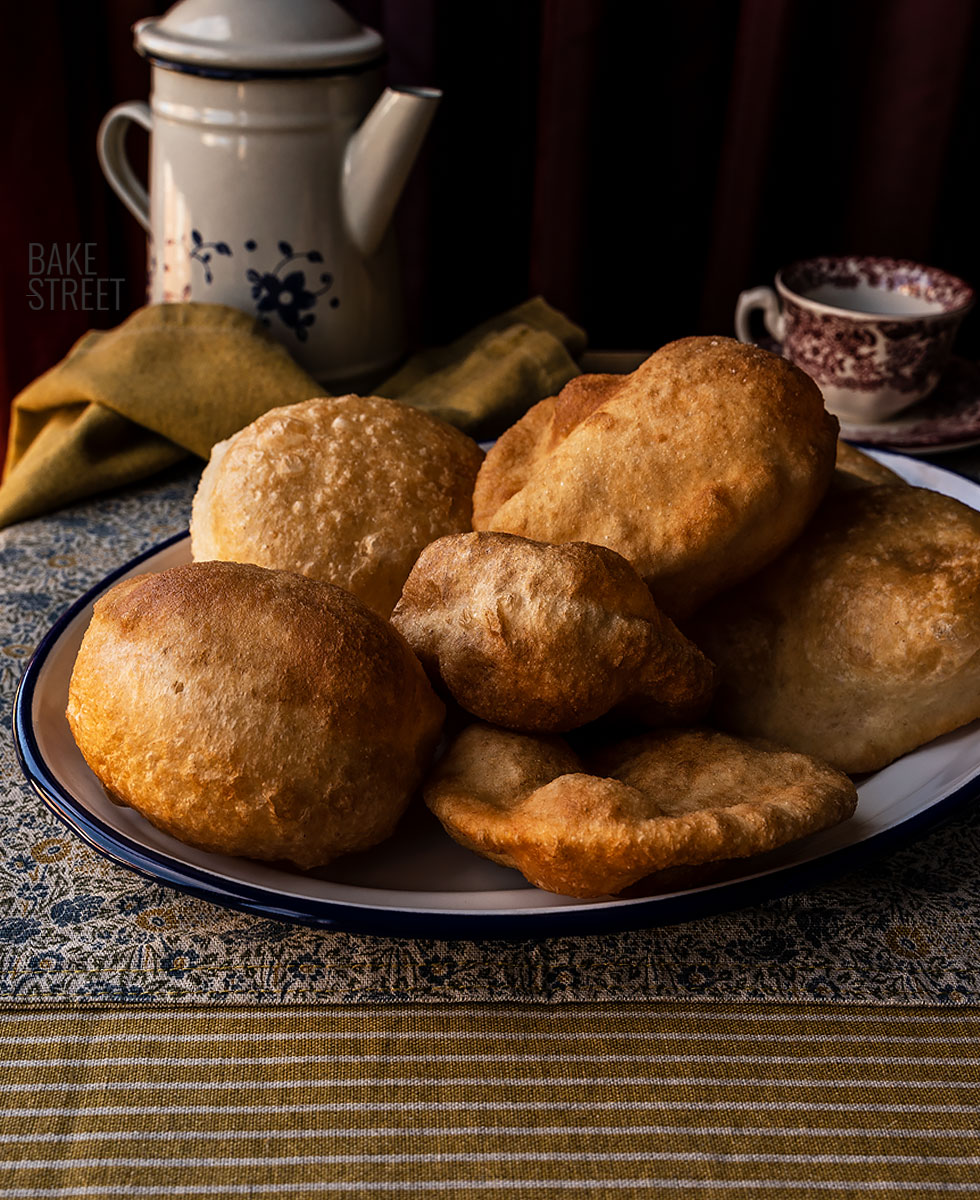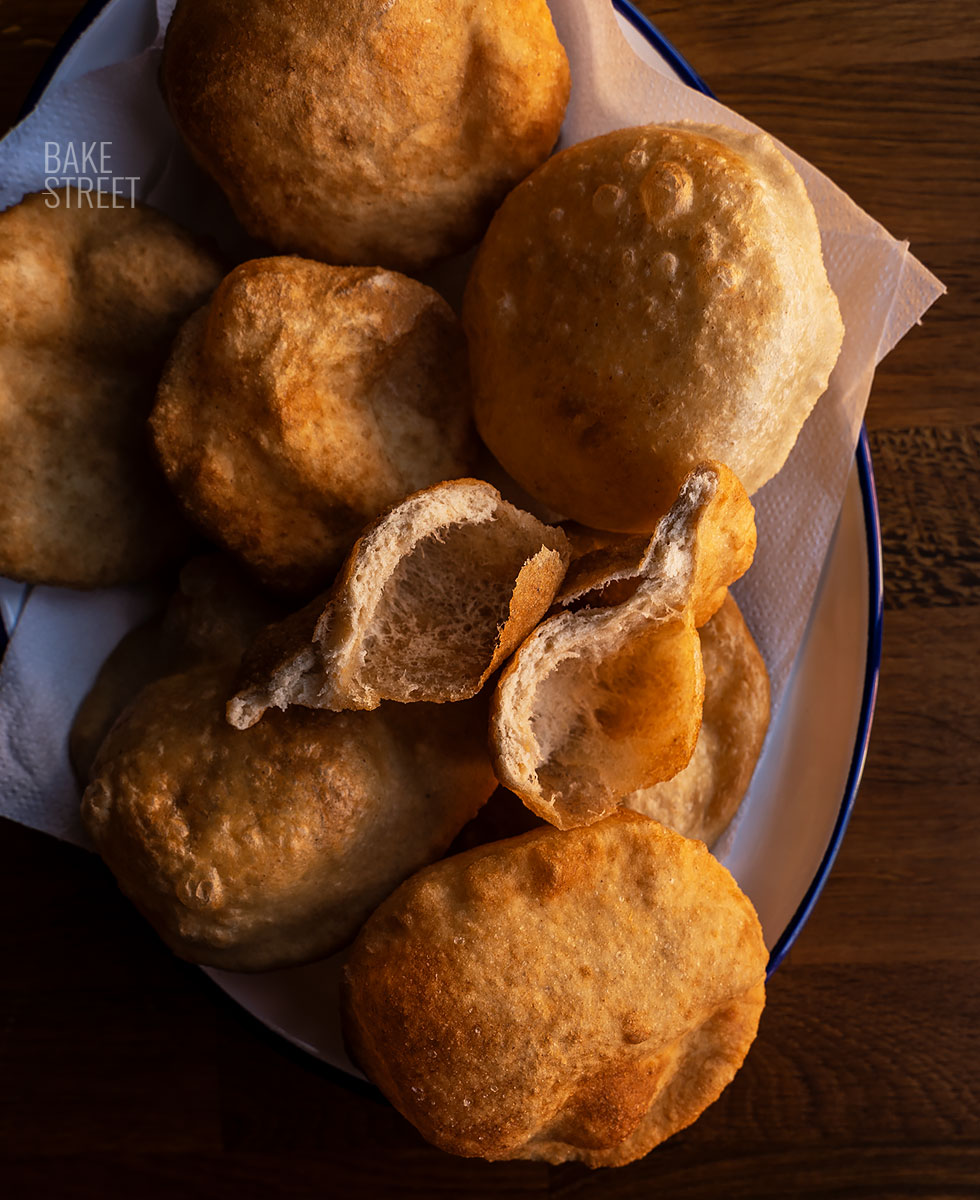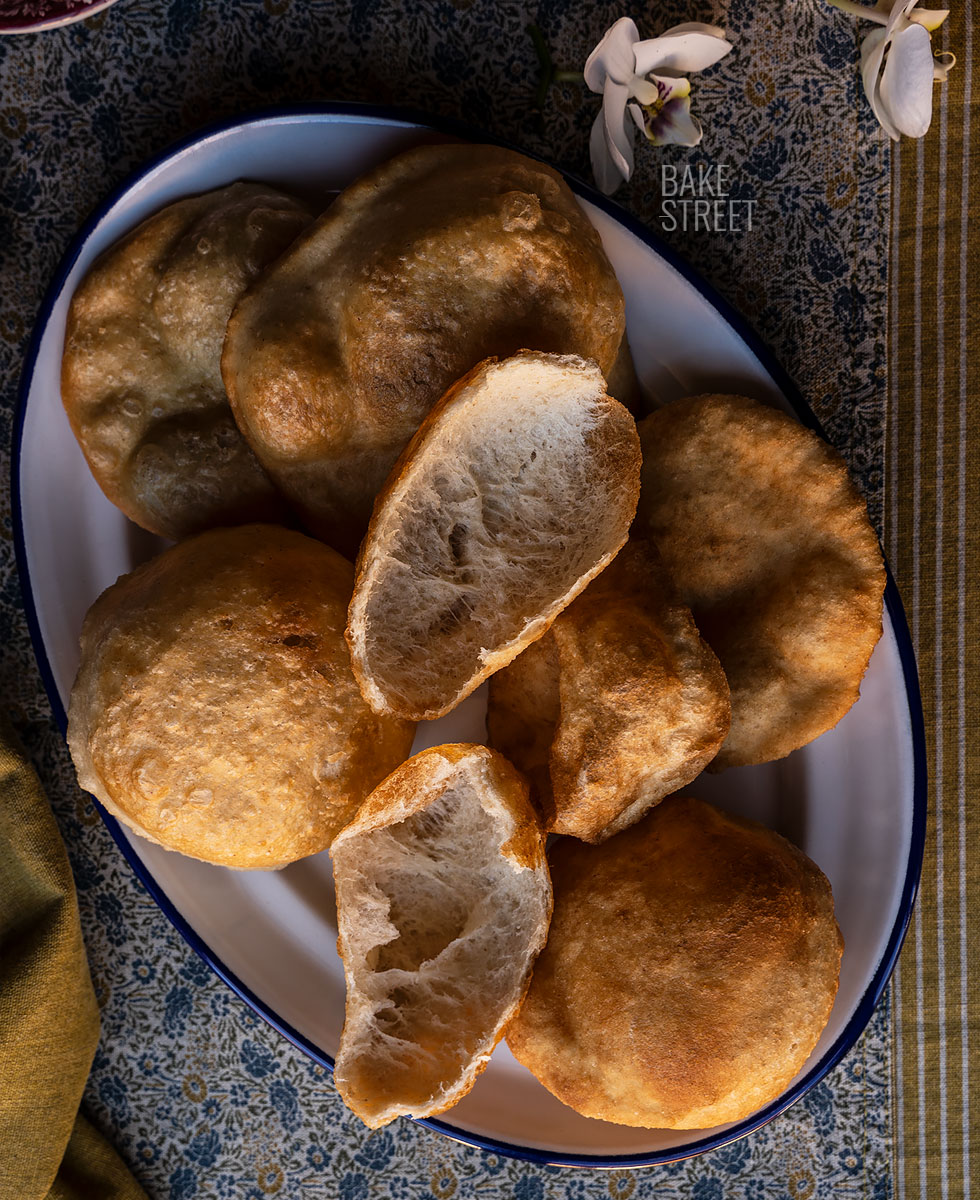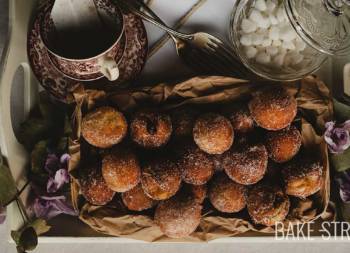
Fried dough – Tortas de pan fritas
I am sure that the recipe I bring you today, you have eaten it (and probably, made it) countless times. But I could not pass up the opportunity to share with you how to make the classic Fried dough – Tortas de pan fritas, also known as tortas fritas, sopaipas, asopaipas, sopaipillas, although the latter are made without yeast unlike tortas de pan. It is a very simple recipe to carry out, but I wanted it to be part of the recipe book that I share with all of you so that you can make them whenever you want.
I remember when I was a little girl that every weekend we would go to visit my maternal grandparents. My grandmother, Maria, always had a huge platter of fried dough made along with freshly brewed coffee. I feel as if I were there right now, that smell as I walked up the stairs to my grandparents’ house. I will never forget it.
It was my grandfather, Manolo, who always opened the door for us, unless he was smoking on the terrace…. In that case, it was my grandmother who welcomed us. When you entered their house, you could feel the warmth of the brazier coming from the living room, her house was very old and did not have central heating like today’s homes. That warmth was accompanied by the smell of freshly fried dough and café de puchero, as my grandmother called it. Although she actually made it in an Italian coffee pot (which, by the way, I have in my house and is a wonderful memory).
I loved that moment, arriving to see them and being greeted with things they had made. I will always relate this recipe to my grandparents. My mother also made them at home some weekends, but especially at Christmas time. It was a breakfast she used to prepare almost always, we all loved it so much. So, as you can imagine, this simple recipe, I relate it directly to my childhood and family moments.

Origin fried dough – tortas de pan fritas.
The term “torta” is a word shared with several languages; Italian, Portuguese and French (tourte), although with many regional peculiarities. In American Spanish, “torta” refers to a large cake, except in Mexican Spanish where “torta” is the equivalent of the Spanish bocadillo, such as its famous tortas ahogadas.
In Spain, torta refers to all those breads that are flat and round, both savory and sweet, thick or thin.
Torta has its origin in different regional variants such as flatbread, of which the torta de gazpacho or torta cenceña remain in certain areas of Spain. They are also mentioned in Leviticus 24: 5-9, in the Spanish translation of the Bible. Today, the word torta is also used to refer to different types of bread and pastry products depending on the region.
Historically, the difference between torta and bread was its round and flat shape, as well as the absence of yeast in its preparation. The well-known word tortilla, used mainly in Mexico, means a “small cake”, while tortada means “big cake”. In most regions, a torta is considered inferior in value to traditional bread. This is reflected in a well-known Spanish saying: A falta de pan buenas son tortas – For lack of bread, tortas are well received.
Torta frita is a fried flatbread eaten in Uruguay and Argentina. In the latter, it is customary to accompany it with mate.

Sopaipilla.
This simple preparation, made with bread dough, has its origin in Germany and it is believed that it was brought to the Río de la Plata by Spanish immigrants from the south, since this recipe was deeply rooted in Andalusian cuisine. The Arabs called this cake “sopaipilla“, a term that in turn comes from the Germanic “suppa” and means “bread soaked in liquid“.
It is a type of fried food made from a wheat flour dough that is later fried in oil or lard. The traditional shape is usually round and with a central hole that allows them to be cooked without swelling, as well as making them easier to pick up or eat. The ingredients of the recipe can have many variations depending on the area where it is made.
Not all fried doughs are made with yeast; some of them are made without this leavening agent, resulting in a bread that is more crunchy than spongy. The rest of the components remain the same or very similar in all cases.
To carry them out we will not have to complicate us in excess, it will be enough to elaborate a simple bread dough, to knead it until achieving a good development of the gluten and to let it rise. Afterwards, divide the dough, knead, flatten and fry it. My mother didn’t ball the dough. She divided the dough directly from the large piece into portions of different sizes, flattened and fried. Each one had a different shape and I liked that. You could see that it was something homemade.
Ingredients Fried dough
Ingredients for 8 tortas de pan fritas (fried dough)
DOUGH:
- 200 g bread flour
- 125 g water
- 4 g fresh yeast or 1,3 g dry yeast
- 15 g unsalted butter, room temperature
- 3,5 g salt
FOR FRYING:
- 1/2 liter mild olive oil
MATERIAL WE WILL NEED:
- bowls
- digital kitchen scale
- rolling pin
- scraper
- frying pan
Instructions
Preparamos dough for tortas de pan.
- In a large bowl, add the flour together with the water and the crumbled fresh yeast. Start mixing with your hands until you get a more or less homogeneous dough.
- In my case, I prefer to add the water little by little. That way we can integrate the ingredients more easily, as well as control the final hydration of the dough (so as not to overdo it). Remember that each flour may have a different absorption capacity, despite being the same type.
- Incorporate salt and continue kneading to achieve an amalgamated dough.
- Transfer the dough to a clean work surface and knead until a moderately developed gluten is obtained.
- At that moment, begin to incorporate the butter. We will do it little by little and waiting for it to be completely integrated before adding more.
- Once we have integrated all the butter, knead until we get a well developed dough.
- Roll the dough and put it in a bowl, cover it with plastic wrap and let it rise until it almost triples its volume. In my case it was 2 hours and 20 minutes to 75ºF/24ºC.
Preshape the dough.
- Dump the dough onto a clean work surface and gently degas it.
- Divide the dough into 8 pieces of approximately 40 g each.
- Gently roll and let rest, covered with plastic wrap, for 20 minutes. Remember that if we get scraps of dough when dividing the pieces, these should be placed in the center of the dough before preshaping and shaping.
Strech and fry.
- Pour olive oil in a saucepan and place over medium high heat. Let it reach 355º-365ºF/180º-185ºC, being careful not to overdo it to avoid smoking. If the oil does not have temperature, the dough will sink, it will take time to rise and it will take too much oil.
- Take one of the pieces and flatten it with the palm of your hand, gently.
- Stretch with the help of a rolling pin, we will give an approximate diameter of 10 cm in diameter.
- Transfer in the hot oil and fry.
- We will observe that the dough will grow and expand very quickly. As soon as it acquires a nice golden color, turn it over with the help of two forks or a skimmer, as you prefer.
- Before taking it out, we must make sure that the dough has browned all over its surface.
- Remove and place on a plate with absorbent kitchen paper.
- Repeat the same process with the rest of the pieces.
- Once fried, serve and consume immediately.

Notes
- To make this fried bread dough, I used bread flour. You can use any variety of flour that has a W=200 or similar.
- Remember that the final amount of water may vary according to the absorption capacity of our flour. Even if it is the same type, the milling or grinding can directly affect this aspect as well as the quality of the grain.
- We can use fresh or dry yeast indistinctly. We must remember that 1 g of dry yeast is equivalent to 3 grams of fresh yeast. The first variety of yeast is concentrated, hence less quantity is needed.
- It is important to develop the gluten well to obtain a good result when frying. The size of tortas de pan can be varied. In my case I leave them as I make them at home, but you can make them smaller if you wish. Even with another shape.
- The thickness that we give to the pieces when we stretch it, as well as the diameter, will affect the way it will rise or grow when we fry it. Even if when stretching the dough, it folds, that will mean that when frying it will not do so evenly.
- In the video I have made various sizes, the ones that are perfectly soft have an approximate diameter of 10 cm, according to the weight that I leave you in the elaboration.
- Tortas de pan can be fried in mild olive oil, sunflower oil or another variety of vegetable oil. In my case I like to do it in olive oil because the final flavor is extraordinary and very characteristic.
- What is mild olive oil? Mild olive oil is one of the most consumed olive oils in Spain. It is a refined olive oil, in which it has been blended with virgin olive oils in a smaller proportion than in the intense olive oil, known as 1 grade olive oil, which gives it a lower degree of acidity. Mild olive oil has 0.4 grade of acidity.
- Ideally, they should be eaten at the same time they are fried. Or a few hours later, but it is a preparation that does not last well from one day to the next. The best is to consume them when they are cooked.

I hope you are motivated to make this Fried dough - Tortas de pan fritas at home, either for the first time or to recall beautiful memories. I am sure you will enjoy preparing them at home, not only because of how simple they are, but also because of the incredible result we get from something so simple.
In my case we have always eaten them as they are, but I know that some people sprinkle them with sugar, honey, syrup.... Or even accompany them with hot chocolate. As for me, I have always eaten them with coffee with milk (caffee latte). Well, not when I was little, but when I was older, yes, and I admit that I love them, I can eat tons of them!
I hope you enjoy them and let me know what you think.
I wish you a wonderful Sunday! Lots of love,
Eva




